Why (And When) Did Most Car Brands Switch To Plastic Oil Pans?
Vehicles began switching to plastic oil pans because they provide several advantages over metal. This trend goes beyond oil pans, as you may not realize several cars have bodies made of plastic. Auto manufacturers are increasingly marketing more efficient engine operation, and weight is an important factor. Basic physics explains that the more a car weighs, the higher the amount of rolling friction is, requiring more energy to keep it moving. In some cases, a plastic oil pan is half the weight of traditional metal pans, allowing for better fuel economy figures.
In addition, not only are plastic components less expensive to produce, but they also don't suffer issues such as corrosion and rust. It's also much less work to incorporate additional components into each pan. For instance, with a traditional metal oil pan, in order to add things like a drain plug, various sensors, and mounting hardware, it had to be machined, which necessitates additional tasks like welding and painting, which aren't necessarily required with plastic.
Auto makers first introduced a thermoplastic oil pan in the 2008 Mercedes-Benz C class, according to Kunststoffe International, but it wasn't long before the switch started appearing in other models as well. Nissan, Ford, and BMW followed suit on certain models with an increasing number of vehicle components beyond the oil pan getting the plastic treatment.
Plastic oil pans aren't better in every way and some enthusiasts aren't happy about the switch
While they do have their benefits, plastic isn't superior to metal across the board and has some issues of its own. Plastic and heat aren't always the best combination, especially when temperatures get hot enough to warp the material. This isn't usually an issue for someone commuting to work, but it is in the racing world. For high-performance track vehicles, aluminum is a better choice as it offers better heat dissipation than plastic.
While it may be heavier, metal is also much more durable than plastic. In a critical area like the pan, which is where oil collects and is pumped throughout the engine, a leak is a serious problem. Plastic pans can develop problems like cracks, which create an immediate repair need. Worse still, simple mistakes like overtightening the drain plug can cause leaking in a plastic oil pan.
Some automotive enthusiasts have taken to social media claiming car companies are building vehicles cheaply compared to classic cars and incorporating planned obsolescence. Essentially, some argue these parts are plastic so that they'll fail quicker, requiring drivers to go out and buy a new vehicle sooner. Especially concerning to some technicians and automobile fans, is the move towards incorporating even more plastic into the engine itself, posing the question: were old cars built to last longer?

